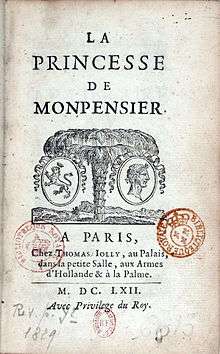Madame de La Fayette
| Marie-Madeleine Pioche de La Vergne comtesse de La Fayette | |
|---|---|
 | |
| Born |
Marie-Madeleine Pioche de La Vergne 18 March 1634 Paris, France |
| Died |
25 May 1693 (aged 59) Paris, France |
| Pen name | Madame de La Fayette |
| Occupation | Novelist |
| Language | French |
| Nationality | French |
| Period | 17th century |
| Literary movement | Classicism, Précieuses |
| Notable works | La Princesse de Clèves |
| Spouse | François Motier, comte de La Fayette |
| Children |
|
| French literature |
|---|
| by category |
| French literary history |
| French writers |
|
| Portals |
|
Marie-Madeleine Pioche de La Vergne, comtesse de La Fayette (baptized 18 March 1634 – 25 May 1693), better known as Madame de La Fayette, was a French writer, the author of La Princesse de Clèves, France's first historical novel and one of the earliest novels in literature.
Life
Christened Marie-Madeleine Pioche de La Vergne, she was born in Paris to a family of minor but wealthy nobility. At 16, de la Vergne became the maid of honour to Queen Anne of Austria and began also to acquire a literary education from Gilles Ménage, who gave her lessons in Italian and Latin. Ménage would lead her to join the fashionable salons of Madame de Rambouillet and Madeleine de Scudéry. Her father, Marc Pioche de la Vergne, had died a year before, and the same year her mother married Renaud de Sévigné, uncle of Madame de Sévigné, who would remain her lifelong intimate friend.
In 1655, de la Vergne married François Motier, comte de La Fayette, a widowed nobleman some eighteen years her senior, with whom she would have two sons. She accompanied him to country estates in Auvergne and Bourbonnais although she made frequent trips back to Paris, where she began to mix with court society and formed her own successful salon. Her sister-in-law was Louise de La Fayette (1618–1665), favourite of Louis XIII of France. Some of her acquaintances included Henrietta of England, future Duchess of Orleans, who asked La Fayette to write her biography; Antoine Arnauld; and the leading French writers Segrais and Huet. Earlier on, during the Fronde, La Fayette had also befriended the Cardinal de Retz.
Settling permanently in Paris in 1659, La Fayette published, anonymously, La Princesse de Montpensier in 1662. From 1665 onwards she formed a close relationship with François de La Rochefoucauld, author of Maximes, who introduced her to many literary luminaries of the time, including Racine and Boileau. 1669 saw the publication of the first volume of Zaïde, a Hispano-Moorish romance which was signed by Segrais but is almost certainly attributable to La Fayette. The second volume appeared in 1671. The title ran through reprints and translations mostly thanks to the preface Huet had offered.

La Fayette's most famous novel was La Princesse de Clèves, first published anonymously in March 1678. An immense success, the work is often taken to be the first true French novel and a prototype of the early psychological novel.
The death of La Rochefoucauld in 1680 and her husband in 1683 led La Fayette to lead a less active social life in her later years. Three works were published posthumously:
- La Comtesse de Tende (1718),
- Histoire d'Henriette d'Angleterre (1720), and
- Memoires de la Cour de France (1731).
See also
External links
| Wikiquote has quotations related to: Madame de La Fayette |
| Wikisource has original works written by or about: Madame de La Fayette |
| Wikimedia Commons has media related to Marie-Madeleine de la Fayette. |
- Works by Marie-Madeleine Pioche de La Vergne La Fayette at Project Gutenberg
- Works by or about Madame de La Fayette at Internet Archive
- Works by Madame de La Fayette at LibriVox (public domain audiobooks)

- Catholic Encyclopedia entry


| ||||||
|